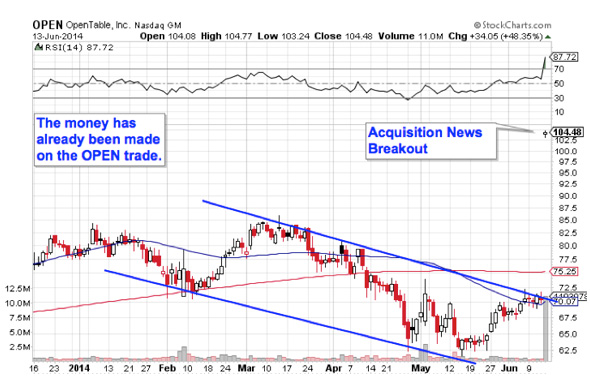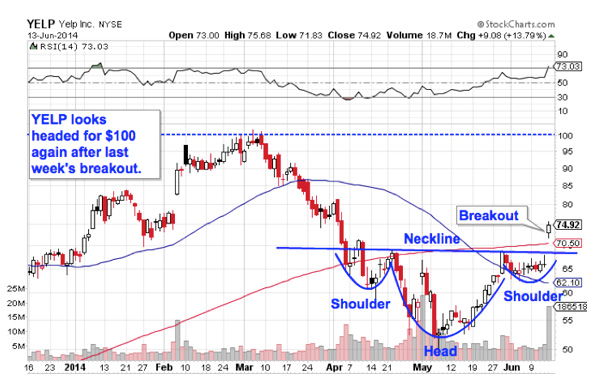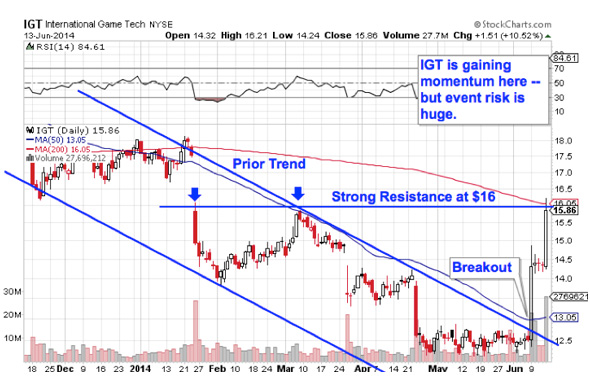Data traffic is expected to grow 23% annually over the next four years. Growing data creates complexity in managing and securing data. Data centers are moving towards the next-generation of virtualization and cloud environment. As a result, many networking companies are updating their products and technology to step up security and data management. Three such companies discussed in this post are developing various technologies to simplify data management and capitalize on the expanding market.
For the second quarter of fiscal 2014, F5 Networks, Inc. (FFIV) announced revenue of $420.0 million, up 3 percent from $406.5 million in the prior quarter and 20 percent from $350.2 million in the second quarter of fiscal 2013. Moreover, revenues were positively impacted by an 18.0% hike in Services revenues and a 21.6% increase in Product revenues on a year-over-year basis.
Application Delivery Controller, or ADC, segment accounts for the product revenue of the Company. Product revenue of $225.1 million grew 3% sequentially and 22% year-over-year, representing 54% of total revenue.. With improvisation in data centers, it announced an updated version of its chief ADC platform software, BIG-IP.
The updated version of BIG-IP, called BIG-IP v11.4, simplifies management of applications and data over physical networks, virtual networks, and cloud environment. This updated software will enhance its ADC segment. Furthermore, Cisco's exit from the ADC market will add to F5 Networks' market share growth opportunity. Its market share is expected to improve from 27.1% currently to 27.6% by the end of fiscal year 2015.
The increasing usage of 3G and 4G data from mobile devices is increasing the demand for content and applications. This situation is increasing network complexity and reducing security, increasing the probability of cyber attacks. The security products S/Gi firewall, offered by the company, is certain to benefit from this market of cyber security. This product protects the network service providers' infrastructure to ensure network availability and performance.
It will also protect subscribers from threat during data sharing. S/Gi will enhance connections per second by 20 times, which is equivalent to 8 million people using a service providers' network. This product will also contribute to F5 Networks' total revenue as the cyber security markets rises due to increased data traffic.
Data centers are becoming the foundation of every organization, and I.T. departments are moving towards cloud storage and virtualization. With organization adapting to various SAAS (Software As A Service) application deployed over cloud had created new market for data centers. To capitalize on this, Citrix Systems (CTXS): and Cisco recently expanded their strategic alliance to provide advanced technology in this market. The companies have been in partnership for the past two years.
Under this expanded alliance, Citrix will deliver its ADC technology 'NetScaler' to Cisco. NetScaler is a device that provides load balancing across multiple computer networks. In addition, this alliance recently released the next-generation of NetScaler called Netscaler10. NetScaler 10, its next-generation application delivery controller (ADC) that is the company's answer for bringing dynamic elasticity to the network. NetScaler 10 has automatic failure identification and management, which means that if there is a failure, NetScaler will identify it and automatically switch workloads to another ADC.
Cisco's technical support center will assist this new technology and will sell it through its various channel partners. As Cisco has already made an exit from the ADC market, this alliance will help the company serve its existing customers, without actually producing ADC products.
With this, Cisco will provide cloud network service to Citrix so it can develop a highly advanced cloud platform. The combination of the new NetScaler and the cloud service will strengthen Citrix's ADC market. The flexible licensing policy of the company enables the customers to easily opt for NetScalar. Pay-As-You-Grow pricing policy, provides investment protection, avoids costly hardware upgrades, and reduces TCO
The bottom line The companies are capitalizing on the opportunity provided by the shift in data management trends by updating their technologies and products. F5 Networks is enhancing its ADC segment with new security products for mobile threats. Citrix and Cisco are expanding their partnership to evolve the next generation ADC portfolio.
I would recommand a but for both these companies.
| Currently 0.00/512345 Rating: 0.0/5 (0 votes) | |

Subscribe via Email

Subscribe RSS Comments Please leave your comment:
More GuruFocus Links
| Latest Guru Picks | Value Strategies |
| Warren Buffett Portfolio | Ben Graham Net-Net |
| Real Time Picks | Buffett-Munger Screener |
| Aggregated Portfolio | Undervalued Predictable |
| ETFs, Options | Low P/S Companies |
| Insider Trends | 10-Year Financials |
| 52-Week Lows | Interactive Charts |
| Model Portfolios | DCF Calculator |
RSS Feed  | Monthly Newsletters |
| The All-In-One Screener | Portfolio Tracking Tool |

MORE GURUFOCUS LINKS
| Latest Guru Picks | Value Strategies |
| Warren Buffett Portfolio | Ben Graham Net-Net |
| Real Time Picks | Buffett-Munger Screener |
| Aggregated Portfolio | Undervalued Predictable |
| ETFs, Options | Low P/S Companies |
| Insider Trends | 10-Year Financials |
| 52-Week Lows | Interactive Charts |
| Model Portfolios | DCF Calculator |
RSS Feed  | Monthly Newsletters |
| The All-In-One Screener | Portfolio Tracking Tool |
FFIV STOCK PRICE CHART

111.11 (1y: +60%) $(function(){var seriesOptions=[],yAxisOptions=[],name='FFIV',display='';Highcharts.setOptions({global:{useUTC:true}});var d=new Date();$current_day=d.getDay();if($current_day==5||$current_day==0||$current_day==6){day=4;}else{day=7;} seriesOptions[0]={id:name,animation:false,color:'#4572A7',lineWidth:1,name:name.toUpperCase()+' stock price',threshold:null,data:[[1372654800000,69.61],[1372741200000,68.94],[1372827600000,69.32],[1373000400000,69.19],[1373259600000,68.52],[1373346000000,69.36],[1373432400000,71.95],[1373518800000,76.09],[1373605200000,79.79],[1373864400000,81.41],[1373950800000,80.43],[1374037200000,80.9],[1374123600000,81.74],[1374210000000,80.29],[1374469200000,80.34],[1374555600000,79.91],[1374642000000,81.42],[1374728400000,87.29],[1374814800000,87.65],[1375074000000,86.8],[1375160400000,87.89],[1375246800000,87.8],[1375333200000,89.04],[1375419600000,88.45],[1375678800000,88.73],[1375765200000,88.46],[1375851600000,88.38],[1375938000000,90.22],[1376024400000,89.88],[1376283600000,92.7],[1376370000000,93],[1376456400000,92.5],[1376542800000,89.23],[1376629200000,87.49],[1376888400000,85.7],[1376974800000,86.81],[1377061200000,85.38],[1377147600000,87.69],[1377234000000,87.1],[1377493200000,85.86],[1377579600000,82.84],[1377666000000,83.22],[1377752400000,84.12],[1377838800000,83.38],[1378184400000,85.02],[1378270800000,85.4],[1378357200000,86.52],[1378443600000,86.88],[1378702800000,88.44],[1378789200000,89.96],[1378875600000,92.02],[1378962000000,90.63],[1379048400000,92.01],[1379307600000,90.88],[1379394000000,91.632],[1379480400000,92.942],[1379566800000,93.1],[1379653200000,93.618],[1379912400000,89.17],[1379998800000,87.07],[1380085200000,87.99],[1380171600000,88.1],[1380258000000,86.8],[1380517200000,85.808],[1380603600000,88.97],[1380690000000,89.88],[1380776400000,88.45],[1380862800000,91.54],[1381122000000,92.02],[1381208400000,88.79],[1381294800000,87.9],[1381381200000,89.22],[1381467600000,90.5],[1381726800000,90.21],[1381813200000,87.55],[1381899600000,88.52],[1381986000000,85.922],[1382072400000,87.81],[1382331600000,90.11],[1382418000000,90.65],[1382504400000,86.31],[1382590800000,85.152],[1382677200000,82.709],[1382936400000,84.28],[1383022800000,84.16],[1383109200000,83.49],[1383195600000,81.535],[13! 83282000000,79.43],[1383544800000,79.55],[1383631200000,79.74],[1383717600000,81.2],[1383804000000,80.39],[1383890400000,82.02],[1384149600000,82.86],[1384236000000,84.13],[1384322400000,84.64],[1384408800000,84.05],[1384495200000,84.62],[1384754400000,83.89],[1384840800000,82.02],[1384927200000,81.56],[1385013600000,82.912],[1385100000000,82.94],[1385359200000,80.9],[1385445600000,81.84],[1385532000000,82.38],[1385704800000,82.26],[1385964000000,82.05],[1386050400000,82.08],[1386136800000,82.81],[1386223200000,81.5],[1386309600000,83.59],[1386568800000,85.18],[1386655200000,84.72],[1386741600000,84.24],[1386828000000,81.99],[1386914400000,81.47],[1387173600000,83.44],[1387260000000,84.25],[1387346400000,84.11],[1387432800000,84.98],[1387519200000,88.1],[1387778400000,89.51],[1387864800000,89.44],[1388037600000,89.28],[1388124000000,89.22],[1388383200000,89.89],[1388469600000,90.86],[1388642400000,88.89],[1388728800000,88.03],[1388988000000,87.78],[1389074400000,89.64],[1389160800000,89.37],[1389247200000,88.06],[1389333600000,88.52],[1389592800000,92.01],[1389679200


